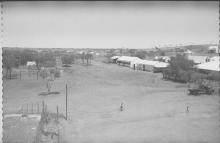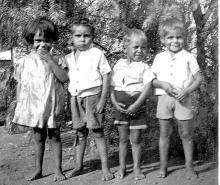Mount Margaret
BTH Oral history project, Doris: http://nla.gov.au/nla.obj-218435613/listen ; BTH Oral history project, Eileen: http://nla.gov.au/nla.obj-218348735/listen
-28.795436, 122.184031Some people considered Mount Margaret Mission as an alternative destination for children who were labelled 'half caste' by legislation and government policy . These children would otherwise have been removed from their families and taken to the Moore River Mission near Perth, nearly 1,000 kilometres away . The quality of care at Moore River was known to be substandard and a former nurse at Mount Margaret recalled that the children arriving from Moore River Òwere in a dreadful stateÓ . Because of this, some parents voluntarily placed their children at Mount Margaret. However, it is acknowledged that many parents had no choice, and that many children were also forcibly removed from their families. Mount Margaret believed that assimilation was important and Aboriginal and Torres Strait Islander languages were prohibited. Children were prevented from leaving, but some did escape .
0Established in 1921, closed in 1975 and ownership was passed onto residents.
Mount Margaret MissionWestern Australian Museum, Missions, Settlements and Reserves http://museum.wa.gov.au/explore/wa-goldfields/first-peoples/missions-settlements-and-reserves
John Bannister, Interview with Kathleen Mack (Oral History Report, 16 January 2001) http://nla.gov.au/nla.obj-218367374/listen
Western Australian Museum, Missions, Settlements and Reserves http://museum.wa.gov.au/explore/wa-goldfields/first-peoples/missions-settlements-and-reserves
WAAnindilyakwa Land Council
http://anindilyakwa.com.au/
Anindilyakwa Land Council, Anthropology, Anindilyakwa Land Council
http://anindilyakwa.com.au/culture/anthropology
Every morning our people would crush charcoal and mix that with animal fat and smother that all over us, so that when the police came they could only see black children in the distance. We were told always to be on the alert and, if white people came, to run into the bush or run and stand behind the trees as stiff as a poker, or else hide behind logs or run into culverts and hide. Often the white people - we didn't know who they were - would come into our camps. And if the Aboriginal group was taken unawares, they would stuff us into flour bags and pretend we weren't there. We were told not to sneeze. We knew if we sneezed and they knew that we were in there bundled up, we'd be taken off and away from the area. There was a disruption of our cycle of life because we were continually scared to be ourselves. During the raids on the camps it was not unusual for people to be shot - shot in the arm or the leg. You can understand the terror that we lived in, the fright - not knowing when someone will come unawares and do whatever they were doing - either disrupting our family life, camp life, or shooting at us (p. 21).
Confidential evidence 681, Western Australia: woman ultimately surrendered at 5 years to Mt Margaret Mission for schooling in the 1930s.
Human Rights and Equal Opportunity Commission, Bringing them Home: National Inquiry into the Separation of Aboriginal and Torres Strait islander Children from Their Families (1997)
5 years Confidential evidence 681
Mount Margaret Mission, 1956

Mount Margaret Mission, 1949

Mount Margaret Mission, 1949
